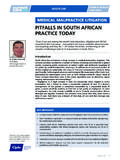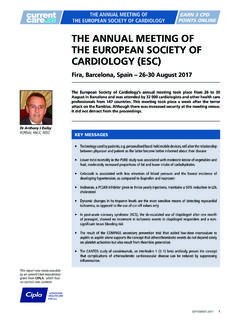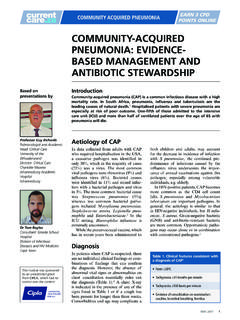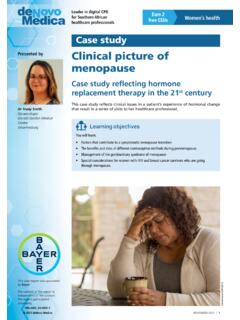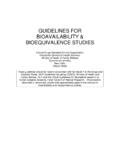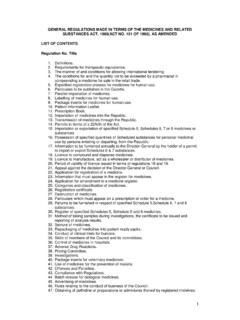Transcription of Ethics of prEscription - deNovo Medica
1 1 Earn 6 cpD Ethics pointsEthicsMay 2017 Professor Umesh G LallooMBChB, FCP, DoH, MD, FCCP, FRCP, Fellow of the University of KwaZulu-Natal Durban Gateway Private and Mount Edgecombe Hospital Director of the Enhancing Care FoundationDurbanThis article was made possible by an unrestricted educational grant from CIPLA, which had no control over of prEscription Much of a physician s assessment of a patient ends in a prEscription ; when, in actual fact this is only the professor Lalloo pointed out at the outset of his review of the ethical responsibility of doing good, without harm as the guiding principle in medicine. KEY MESSAGES Prescribing medication demands ongoing review of possible adverse effects, as the clinician s care of a patient continues over ensuing months and years Side effects of chronic medication can have a slow onset and the clinician should be alert to this potential harm Affordability of generics is greatly enhanced by a competitive environment in which there are at least 10 generic products for a particular drug entity Adverse events associated with prescribed medication are extremely poorly reported in South Africa.
2 This needs greater attention from practising clinicians There is no MCC-approved list of non-substitutable medicines : while there is concern about medicines with a narrow therapeutic range, practical steps can be taken to achieve expected clinical principle should be uppermost in a clinician s mind as he prepares to write a prEscription for the patient in front of him. The prEscription must reflect an effort to prevent or remove harm, while weighing and balancing potential benefits of therapy against risks. The patient s wishes need to be considered, and over-riding them as unimportant is paternalis-tic and against the concept of informed consent (Table 1). In our application of evidence from clinical trials, when we select a patient for treatment, we are expecting a particular response.
3 If the patient does not respond as expected or the clinical problem is difficult, we need to go back to the drawing board using the maxim: When the clinical prob-lem gets tough, the tough get a history . Three case studies are illustrative of the importance of considering risk and benefit when prescribing for an individual - do no harm1. Refrain from providing ineffective treatments2. Do not act with malice towards patients3. Beneficial treatments may have serious side effects4. Do no harm works best when balanced with beneficence Ethics2 May 2017 Earn 6 cpD Ethics points on Accredited CPD modules .Case 1An insulin-dependent diabetic female presents with recurrent urinary tract infection (UTI). She has chronic persistent asthma which is being treated with budesonide 160 and formoterol fumarate dehydrate (Symbicord) twice daily.
4 In recent months her asthma worsened, requiring increasing treatment, but she continued to experience poor control and severe recurrent exacerbations. She is referred to a pulmonologist who identifies the presence of bibasal crackles. On high-resolution computed tomography, the diagnosis of fibrosing alveotitis is made. She is prescribed what was then seen to be appropriate treatment of prednisone and azathioprine; over time she develops right heart failure and is eventually sent home on oxygen , the clinical question remains unanswered: Why did this patient with asthma get idiopathic pulmonary fibrosis? The search for an answer began with her illness and medication history:It was noted that she had been given nitrofurantoin for recurrent UTI, which she had been taking for five years.
5 The product insert and research of published literature revealed that nitrofurantoin can be toxic to the pulmonary system after long exposure (six months).1 If the general practitioner had reviewed this aspect of the patient s history earlier and checked for adverse drug reactions, this lung damage could have been largely 2A 60-year-old woman with pelvic-ureteric reflux is treated for her recurrent UTIs with macrodantin prophylaxis for >5 years; she has a history of smoking and is experiencing progressive nausea. On suspicion that she has chronic obstructive pulmonary disease (COPD), she is referred to a pulmonologist who identifies nitrofurantoin-induced pulmonary toxicity. On CT scan, there is evidence of hepatomegaly.
6 Again, stopping the nitrofurantoin improved liver function and reduced the nausea and the lung function improved. The clinical lesson from this case is that if a patient is on long-term therapy, read about the side effects and monitor the patient, even though, as in this case, the onset of side effects may be 3A 53-year-old electrical engineer, who had never smoked, was diagnosed in 2013 with asthma (cough, tight chest, dyspnoea on effort). He has a history of ischaemic heart disease and a myocardial infarct and a coronary artery stent in situ. He was placed on aspirin therapy; given rosuvastatin for his dyslipidaemia and perindopril plus bisoprolol 10mg for hypertension. He was prescribed salmeterol 25 and fluticasone (250 ) (Sereflo) 2 puffs per day.
7 His symptoms increased progressively and eventually he was using salbutamol up to 15 times per day. He was unable to do normal daily activities without getting short of breath and he felt at death's door . He was given esomeprazole 40mg for his gastro-oesophageal reflux. He also underwent sinus latter medication was the clinical thorn . When the bisoprolol ( -blocker) was stopped, his FEV1 improved within two weeks and he improved steadily. After nine months he was back in the gym!The clinical lesson: if a patient s condition worsens, take a history and check medications. Non-essential medication can even be stopped as part of this checking process to exclude iatrogenic effects. It is clear that -blockers should not be used in asthmatic patients;2 although highly selective -blockers may be safe in some asthmatics, these should only be prescribed in consultation with an expert.
8 Even eye-drops containing -blockers are best avoided in asthmatic elderly are particularly prone to adverse effects of drugs; the overall inci-dence of adverse effects is estimated to be at least twice that of the younger summation, Professor Lalloo stressed that the physician should review his and other healthcare specialists pre-scriptions when a patient either does not respond to therapy or symptoms worsen. The Ethics of prescribing require ongoing review and 2017 Earn 6 cpD Ethics points on Accredited CPD modules .Generic substitution - confidence of quality?The purpose of Act 90, the Medicines and Related Substances Control Amendment Act of 1997, was to provide for sustain-able delivery of competitively priced inno-vative and generic legislation in the USA, the Affordable Care Act (2013) and the FDA Safety and Innovation Act, has acted as an incentive for the development of antibiotics and encouraging biosimilars.
9 Even in this resource-rich environment, competitive pricing of medicines has become FDA policy in order to provide affordable healthcare to all Americans. In South Africa, the Medicines Control Council s (MCC s) role, like that of the FDA, is to ensure that innovator and generic medicines meet the same inter-national standard. This is done by two main mechanisms; ensuring that interna-tional good manufacturing practices are in place and that registered generics are bioequivalent to the innovator medicine, Professor Blockman pointed factories that produce medicines for the South African market are inspected and subjected to random audits, which help to ensure quality medicines are sold in South Africa.
10 The review process for innovator (brand name) drugs differs from that for generic drugs (Figure 1).figure 1. review processBrand name DrugGeneric Drug1. Chemistry1. Chemistry2. Manufacturing2. Manufacturing3. Controls3. Controls4. Labelling4. Labelling5. Testing5. Testing6. Animal Studies6. Bioequivalence7. Clinical Studies8. BioavailabilityCenter for Drug Evaluation & Research, US Food & Drug AdministrationBioequivalence of a generic medicine is based on bioavailability studies in healthy volunteers that show that the same level of the active substance reaches the blood-stream when either the innovator or the generic is given as a single dose in a two-period crossover study. The area under the curve (AUC), maximum concentration reached (Cmax) and time to maximum concentration (Tmax)) must be within the 90% CI (80-125% of the innovator prod-uct s AUC and Cmax as measured on a logarithmic scale) (Figure 2).
